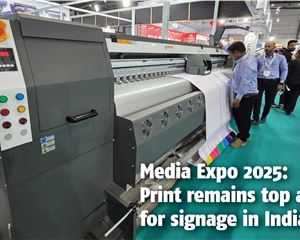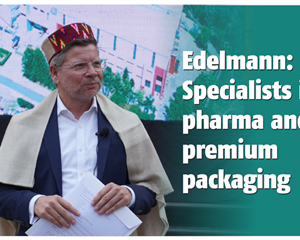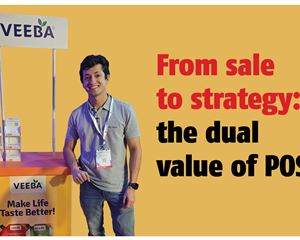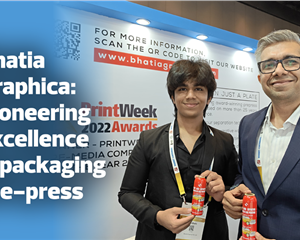The Tale of Two Ink Majors - The Noel D'Cunha Sunday Column
Manufacturers are perhaps the most fearful species in the world, says a top ink maker. “Impact of rise in raw material prices is often not passed-on to customers, even at the cost of thinner bottomline.” Two companies, the Flint Group and Sun Chemical are set to increase the prices of their inks and coatings, effective 1 March.
In this Sunday Column, we find out from Ashwani Bhardwaj, Prashant Atre and Vimal Mehra, what they think about ink...
10 Feb 2018 | By Noel D'Cunha
Ashwani Bhardwaj, managing director at Hubergroup India
PrintWeek India (PWI): Ink consumption on paper media and packaging increased - especially in India - based on its high economic growth. How much did the twin blow of demon and GST impact the bottomlines?
Ashwani Bhardwaj (AB): There is no impact of GST and demonetisation on the bottomline. The topline saw a limited impact for about four months after demonetisation, and for just one month after the GST was implemented. We are all back to normal now in terms of business level, even though there are still issues related to GST implementation.
PWI: GST for printing inks was reduced from 18 to 12% from 15th November 2017 which is good news. But there was a Sin Tax of 28% on varnishes and reducers which were clubbed with cigarettes, liquor and luxury goods. Has the All India Printing Ink Manufacturers Association (AIPIMA) made a representation to the GST Council?
AB: AIPIMA has made the representation. We hope this anomaly will be corrected sometime soon.
PWI: There is an increase in petroleum price. How much will this affect the ink manufacturers’ input raw material prices?
AB: During the last few months costs of several key raw materials used in printing inks have gone up significantly. And this is for reasons other than crude oil price increase. Major increases are in azo pigments, vegetable oils, carbon black, titanium dioxide and major raw materials for UV products. Apart from the price increase, there are serious availability concerns. We shall see the impact of rising crude price in the coming months. So ink industry is passing through a very challenging phase in terms of input costs.
PWI: What are the trends we are seeing in the liquid ink space? Does India remain a dominant gravure market? Or a mindset shift to flexo (narrow and CI) has begun?
AB: India no doubt is largely a gravure market. But flexo is shaping up well. We feel in the coming years, flexo will lead the growth in flexible packaging. Advantages of flexo are now so clear, which is why there are more new investments in flexo machines.
PWI: There was a flurry of capital which was pumped into ink factories? Did the momentum continue in 2017? Or ink companies focussed on streamlining and de-bottlenecking? What does your survey say?
AB: India is gradually emerging as a major manufacturing base for all the leading global ink companies. We may not see big investments for some time as companies are still leveraging their existing capacities. But there will be more investments in future.
PWI: From an application point of view, we noticed the strongest growth coming from an increasing demand for low migration solutions, UV inks for food packaging as well as other sensitive applications for cosmetics and pharmaceuticals. Your view about low migration inks? What is the total percentage of use?
AB: Low migration as a concept is still new to India. End users are still dealing with broader compliance and product safety issues. But the awareness is growing, particularly in the pharma and food sectors. At this point of time consumption of low migration ink is almost nil. Use of UV inks and coatings is growing very fast not only for safety but also for productivity reasons.
PWI: Curious to know what is happening in the metal decorating coatings & inks space? Some movement in the past 2-3 years?
AB: Metal packaging has now stabilised and has a dedicated usage in several product categories. After the steep decline witnessed during the nineties due to competition from plastics, metal packaging industry is now growing in line with the rest of packaging industry.
PWI: The global UV ink market will reach USD 3.5-billion in 2020, with a CAGR of 15.7% from 2015-2020. What are the India numbers for UU inks? Is there going to be a trickle-down effect in India? It remains a top-heavy investment for the big players.
AB: UV in India is already growing at about 12%-15% per annum, and will stay in line with global trends. This growth rate is likely to continue for some time. I believe the growth is across segments, not just packaging.
PWI: The future of UV in terms of safety and regulations?
AB: There are regulatory and safety concerns with some cheaper products available in the market. We at Hubergroup are keeping track and following the latest developments in terms of safety. It is lot of R&D work and we have invested heavily in technology upgrade as well as our manufacturing capacities.
PWI: What's your India print and packaging industry outlook for 2018?
AB: Commercial printing, including print media, is likely to grow at a very slow pace. But still, there will be growth in this segment – in my view about 5%. Packaging should grow at a rate of more than 10% if the broader economic and political indicators remain the way they are today.
Prashant Atre, managing director of Toyo Ink Arets

PrintWeek India (PWI): Talking about 2017, there was high economic, more consumption of paper media and packaging. Had it not been for demon and GST, it would have been even better?
Prashant Atre (PA): Any large-scale disruptive move is sure to have some impact, so did demonetisation and the GST implementation. The economic indicators have already suggested that India is the only country among the large economies that have registered lesser growth in 2017 over 2016. But a country whose captive consumption is about 80% also has the ability to recover quickly.
PWI: How quick?
PA: The effect of demon was seen for about a couple of months and reflected in the business numbers. Thus to some extent on overall bottomline, but it was recovered. The estimated impact is about 3% on bottomline. The case of GST is different as compared to demonetisation. GST is a long-term tax reform activity and its uniqueness is that, it is a destination tax. So, it will positively impact on bottomline for the organised companies and it must have negatively impacted for the unorganised companies. Therefore, it is difficult to measure the impact on bottomline, as it will be on a case-to-case basis.
PWI: Agreed, these are teething problems but it could have been managed better.
PA: How?
PWI: For example, it could be fixed at 12% instead of 18% to begin with. It’s now 12%, which is good news. But, there’s the ‘Sin Tax' of 28% on varnishes and reducer which was clubbed with cigarettes, liquor and luxury goods.
PA: This is certainly not a welcome move by the government to have two different tax rates for the same application area. However, ours is a very small industry and therefore, GST council’s attention to our subject is not expected. It is our responsibility to make a strong and repetitive representation to GST council for making such corrections.
PWI: Now the All India Printing Ink Manufacturers Association (AIPIMA) has made a representation to the GST Council ...
PA: I was personally in touch with many governing council members of AIPIMA and all of them have assured me that association will be making representation for the tax rate on varnishes and I believe they have done it. I strongly believe that there should be a strong combined representation jointly by AIPIMA and other printing associations for this case.
PWI: Now we are saddled with an increase in petroleum price. How much will this affect the ink manufacturers’ input raw material prices?
PA: It is no secret that the price increase in crude cil is over 25% since August 2017. This is impacting conventional paste inks and solvent-based inks.
PWI: What about UV inks?
PA: But the increase in UV raw material is more significant. Monomers and photo-initiators prices have been increasing on a weekly basis. It has gone up by over 35% since August 2017. They are still not stable. Moreover, availability of certain photo-initiators is becoming a challenge.
PWI: Grim.
PA: Yes, ink manufacturers are perhaps the most fearful species in the world. Impact of hike in raw material prices is often not passed on to customers, even at the cost of thinner bottomline. However, this time the impact is multifold, and the increase is larger and at the same time, wider. It will be difficult to absorb the impact this time. It needs to be passed on to the customers.
PWI: What’s happening in the liquid ink space? Does India remain a dominant gravure market?
PA: Flexo offers a good alternative to gravure for flexible packaging, especially when the run lengths are shorter. But, to say that it has captured the imagination of flexible converters to replace gravure with CI flexo will be a bit too soon.
PWI: Has a mindset shift to flexo (narrow and CI) begun?
PA: Currently, it is playing a similar role the digital printing is playing in the offset space. Like, some large offset printing houses have kept digital machines for smaller runs, so have flexible converters taken CI flexo along with their large gravure set-ups. In India, we still have only a handful of CI presses. But, certainly, it surely has a bright future in the flexible space.
PWI: You invested in a new office, last year. But there was a flurry of capital which was pumped into ink factories. Did the momentum continue in 2017?
PA: I think ink companies consolidated and will continue to do so for some time now since the increase in raw material prices are already putting pressure on EBDITA and making any fresh investment may be delayed.
PWI: Are ink companies focused on streamlining and de-bottlenecking?
PA: Government policy and next year's election will make decision makers think twice before making any major expansion. Having said this, companies will still go with expansion, if they have a management-approved plan and allocated funds for it.
PWI: Your numbers for 2018?
PA: On a lighter note, I still have not visited Bejan Daruwala for my numbers for 2018. But on your question, well, print-packaging continues to grow over 15% CAGR for India and UV continues to attract and fascinate a large number of new users. We hope that it will continue to be around 20% for us in 2018.
PWI: Global numbers show that the strongest growth is coming from an increased demand an increasing demand for low migration solutions, UV inks for food packaging as well as other sensitive applications for cosmetics and pharmaceuticals.
PA: We, at Toyo Ink Group, firmly believe that all human, irrespective of the colour of their skin or their demography have right to safe food and therefore, food packaging and other sensitive packaging applications must be safe & must comply to food safety norms.
PWI: Your view about low migration inks?
PA: We realised that sooner or later, India will realise the importance of food-safe packaging and will start practising in their choices. Therefore, we installed a dedicated UV ink plant in Belgium for food packaging inks keeping the future in mind. It needs a regulatory change and so also mindset change. Consumers need to pay importance to safe choices over cheaper options to see its real effect on the ground.
PWI: The total percentage of use in India?
PA: At this moment it is in decimals.
PWI: The global UV ink market will reach USD3.5 billion in 2020, with a CAGR of 15.7% from 2015-2020. What are the India numbers for UV inks?
PA: India will outnumber the world CAGR, so does UV inks. I would put it as energy curing inks in place of just UV inks, as we will see a growth in other energy segments like EB, LED etc.
PWI: India numbers for UV inks?
PA: We think it is about 1,500MT and growing. But, it is still very small compared to liquid or conventional paste inks. The UV segment is still approximately 7% of the total ink business.
PWI: What is the future of UV in terms of safety and regulations?
PA: UV or energy curing ink system is relatively very new compared to its counterparts like liquid or paste inks. Therefore, at every stage, it has to pass through the agni pariksha (certification and safely test) much more than other inks. To my belief, this has made UV system safer than some of the liquid inks or cobalt dryer-added paste inks.
PWI: Where is the maximum usage?
PA: Today, our UV inks are used in milk packaging, not only in Europe or US but also in India. That says it all.
PWI: New office, more people at Toyo Ink Arets?
PA: It is a matter of pride for us that, our customers kept us in business for over 14 years. They continue to shower their affection and blessing towards our team, that kept us going stronger and stronger. Bigger office and a bigger team is just a way to ensure that we remain focused towards existing customers even when we continue to add new ones.
Read Vimal Mehra's interview:
We expect ink prices to soar by Rs 8-10 per kg, says Vimal Mehra












 See All
See All